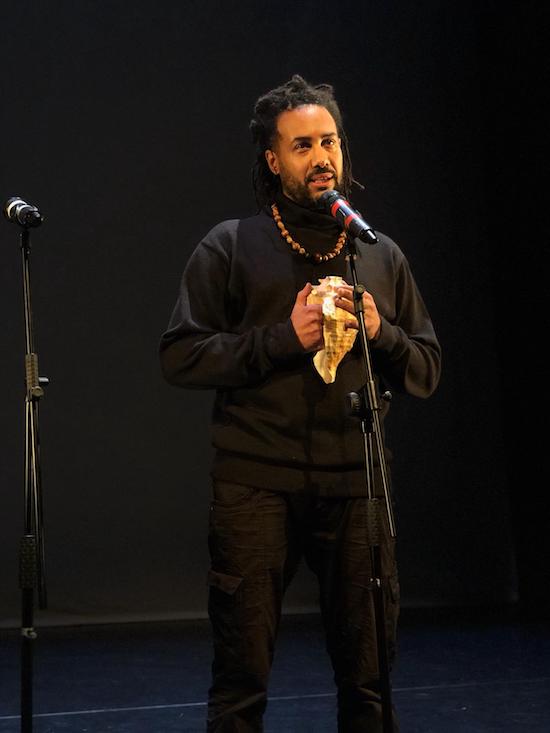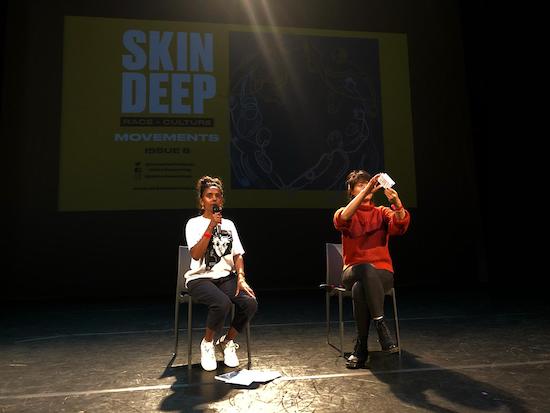Anu Henriques and Sylvia Hong of Skin Deep. Credit to Dhelia Snoussi
As an older black woman, maybe in her forties, fifties, maybe even sixties, closes her fingers around the white railings of a Mancunian building site, she is clutching onto her history. She explains to a white man in a hard hat a few inches shorter than her, on the other side of the railings, what happened here. What happened on the site he is building over, seventy three years ago. There is a plaque on-site which commemorates the 1945 Pan African Congress which he assures her will be safe in the new development. Thank you, she says.
Keeping safe the relics and memories of the people and places of Black British history has been part of the work of the Stuart Hall Foundation’s Black Cultural Activism Map since its inception this year. In partnership with RECLAIM, Voices That Shake and Skin Deep the project sought to map the wealth of creative resistance that forms the past and present of black and brown activists.
In a packed theatre in King’s Cross, the crowd watched on screen as this black woman stood at the site of a seminal event, the 5th Pan African Congress. A series of international events which gathered decolonial thinkers and activists from all over the globe to discuss, plan and plot what became the wave of freedom from colonial rule from the Congo to the Caribbean within the thirty years that followed.
RECLAIM, who produced the film, soon transported us to Liverpool where the International Slavery Museum gave food for thought to a group of young black visitors tracing their roots. We watched as they marvelled at histories of black radicals such as William Davidson, born 1781, executed for his role in the Cato Street Conspiracy, a suspected attempt on the life of the members of the cabinet. As the camera moves from town to town, gallery to museum, youth centre to building site, the search for a lineage begins to bear fruit and a path for these young people to walk on slowly emerges.
It was always the intention behind the Black Cultural Activism Map to create a source of navigation. A tool which enabled a person to take stock of the people and places, the activists and artists whose works have shifted and transformed the landscape and lived experience of black and brown folks in Britain. Commissioned by the Stuart Hall Foundation, a three hour multimedia experience constituted the launch of the project, a journey fit for a map as it ebbed and flowed through the towns of England, islands and lands of the diaspora through time, song, dance and film.
Voices That Shake poet and visual artist, Sai Murray, pulled the audience from Leeds 1969, to Fife 2015 and HMP Holloway 2016, reciting the names of David Oluwale, Sheku Bayoh and Sarah Reed whose black lives which did not matter, black lives ruined and brutally curtailed in police custody. Solemnly, their names boomed out of the soundscape. All eyes were on Akeim Toussaint who, unrehearsed, uses a single prop to bend, stretch and fold through the sounds of Murray’s poetry.The prop a classic road sign, which even before its reveal you recognise from the shape and structure that we are so familiar.

Sai Murray. Credit to Dhelia Snoussi
Danger. Men at work. The ground becomes rocky as the eras blur, twelve white men in suits sit around a boardroom table and we are not quite sure where we are. Berlin 1884? Ayiti 1625? Uruguay 1986? Murray’s piece traverses trauma after trauma of black history, his words beautifully caressed by Toussaint’s movement speaking with power and grace to the call for reparations which has long been ignored. Closing film celebrates the work of Esther Stanford Xosei who has campaigned relentlessly for reparations for decades in this country.
Ascending to a euphoria of future possibles, Nawi collective, lifted us from Southern Africa to East London, the birthplaces of their pieces. The crowd rose to their feet chanting in unison “powerful and dangerous” to the rhythm masterfully controlled by activist and choir leader Amina Gichinga. These first pieces of original material were inspired by intergenerational conversations between black women from across the UK and the diaspora. As clips of those conversations played in the background, Nawi members stepped up to the mic, accompanied by the lulling melody, to recite poetry dedicated to their heroes. From Brixton’s Black Women’s Group to the Abisindi Collective, contributions to community and society from black women are so often forgotten. Nawi, on that day, a collective of black women themselves, remembered them. Many who had been part of the movements and moments they were honouring sat facing them in the audience, weeping.
Bringing us to the hair and now, Globe Poets take us through South London estates, black hair shops on the High Road and banners which hang on new developments, attempt to plaster over the decimation of communities swept out. The offer: new homes which start at just £2 million. The hand-held footage of Dhelia Snoussi slides us west as we look at modern-day Kensington and Chelsea where realtors get rich and the poor go up in flames. As, Tasnima Ahmed walks us through the living nightmare of gentrification and social cleansing, we are grounded. Reminded that resistance and action is not a thing of the past but needed today more than ever.
In producing the pieces revealed this weekend, the Black Cultural Activism Map’s work is well underway. The stories unearthed, the artists, the young people who unearthed them, have already begun to offer a compass for those who are beginning to take up the mantle. An event which sat in the gut, as hearts broke and soared. Listening to the story of Dr Erinma Bell, the local activist whose statue became the first sculpture of a woman ever to sit in Manchester Town Hall, a slow realisation dawned. A launch this may have been but this is not the beginning. It is evidence that the fight has already begun.
To discover more about the Black Cultural Activism Map, visit the Stuart Hall Foundation website


